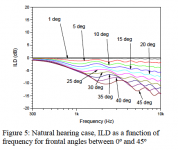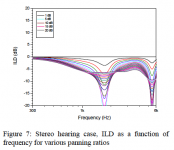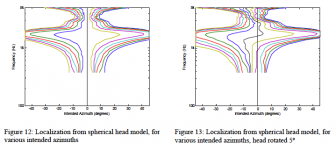..... Notice that for case 5 (no barrier, both speakers on, mic at ear position) the result is almost identical to case 4.
tricky one

Now this one is interesting. It shows how different interaural level differences look between natural hearing and 2-speaker stereo:
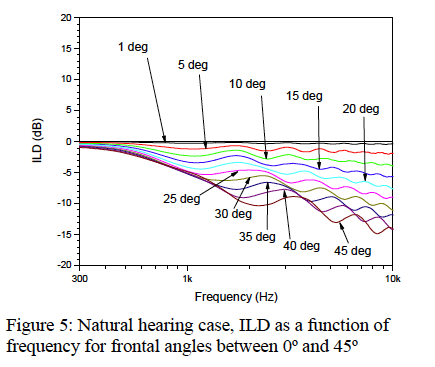
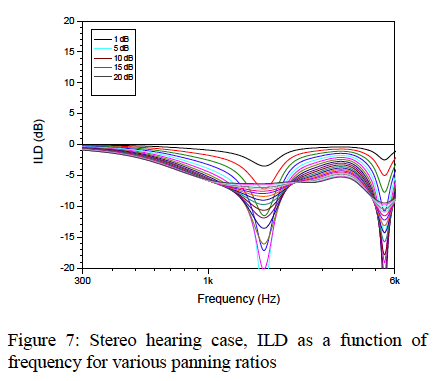
From Benjamin, Brown, AES Convention Paper 7018
From Benjamin, Brown, AES Convention Paper 7018
Attachments
Mmmmh ... I probably need to repeat my experiment ...Hi Rudolf. The hard barrier I used did spread the angle somewhat, yes, but depending on the recording. The hall acoustics are going wider than the speaker spread, it gets more "halo" like.
OK, that is the thing Elias was talking about ...:Then, looking into the AS, ...
... and Markus, Elias and you should feel guilty for persuading me to make the same experienceI think cross talk cancelling is very unfairIt will reveal you the spectacular triumph of stereo, but eventually you just cannot live along with the barrier

Yesterday I returned the desk top to the basement - today I have to move it up to the second floor again ...
Rudolf
No I did not use a head. I suspect it would make some quantitative differences but noting qualitative.
Actually John I would expect to see some significant effects from head diffraction. If head diffraction were indeed not significant then the HRTFs would not be as pronounced as they are.
And we thank you for that!I was just fooling around and figured I post what I got.

This is untrue. Quote from "The Cochlea" by Dallos, 1996 "Thus far, due to the unavailability of suitable techniques, we have no substantive knowledge of how many parts of the Organ of Corti move during acoustic simulation." And that was in 1996. in 1982 very little was know that has held the test of time.Earl, all of this stuff has been known for a long time, from actual measurements, done directly by probing nerve fibers with micro electrodes in live test animals subjected to sound sources.
Upon further reading I found:
"Unfortunately, both approaches (to measuring the physiology of the hair cells) involve specific problems that make it impossible to put together a coherent story at present"
Again, this was in 1996 some 14 years after your quoted source.
But finally I found the real answer which is in fact probably half way between what you were saying and what I was saying.
"The ability of the fiber to synchronize to the stimulus is dependent upon the frequency of the stimulus. As the frequency of the stimulus increases, the fiber has more difficulty synchronizing to the stimulus, and at frequencies above 5 kHz there is little ability to synchronize to the stimulus and the fiber simply increases discharge rate during presentation of the acoustic stimulus."
Clearly by 5 kHz all synchronicity is gone. This means that the effect has to start at a much lower frequency, perhaps as low as a decade lower, maybe less. But clearly from this text, the actual rate of this transition was not even know back in 1996. Obviously this is because the measurements were so difficult to do and had not been done to that point in time.
Actually John I would expect to see some significant effects from head diffraction. If head diffraction were indeed not significant then the HRTFs would not be as pronounced as they are.
I guess I could alwys stick it in my ear, the mic that is.
Actually John I would expect to see some significant effects from head diffraction. If head diffraction were indeed not significant then the HRTFs would not be as pronounced as they are.
Would the inclusion of head diffraction add anything new?
The important data is in the Benjamin/Brown graphs I had posted. It uses a diffraction model. The data shows that there's a huge error in localization cues around 1-2kHz. This might be the explanation why the barrier works.
I didn't say that it would add or subtract anything, just that it is significant.
I have not been following the discussion completely as I have not tried the baffle effect and probably won't.
I see stereo as the medium, as what it is. It doesn't need to be changed or improved, it is what it is and it is used precisely that way by the producer. I don't judge stereo by the same criteria that the baffle image enhancement premise is based on - the recreation of a "you are there" image.
I have not been following the discussion completely as I have not tried the baffle effect and probably won't.
I see stereo as the medium, as what it is. It doesn't need to be changed or improved, it is what it is and it is used precisely that way by the producer. I don't judge stereo by the same criteria that the baffle image enhancement premise is based on - the recreation of a "you are there" image.
Earl, that's exactly what I posted in the first place, but it is all for better understanding so thanks for putting this up.
The white spot in knowledge is indeed with the pickup element: the cochlea. There are some interesting theories around, but not yet real concensus about how everything pieces together. We know a lot about the output, but not about the exact nature of the mechanisme that produces it.
The white spot in knowledge is indeed with the pickup element: the cochlea. There are some interesting theories around, but not yet real concensus about how everything pieces together. We know a lot about the output, but not about the exact nature of the mechanisme that produces it.
Earl, that's exactly what I posted in the first place, but it is all for better understanding so thanks for putting this up.
I understood your post to imply that the loss of synchronicity starts above 5 kHz and I see it as being completely over by 5 kHz. To me those are vastly different positions, but maybe I misunderstood what you were say.
I thought of a way to simulate what this effect in the ear would do to say an impulse response, by mixing coherent and incoherent signals and inverse FFTing them. I suspect that any zero crossings will be obliterated by this, making claims that it is those zero crossings that the ear detects for "imaging". I don't buy that argument.
The important data is in the Benjamin/Brown graphs I had posted. It uses a diffraction model. The data shows that there's a huge error in localization cues around 1-2kHz. This might be the explanation why the barrier works.
What could explain that in a barrier situation the head can be turned quite freely without the same kind of image collapse as in stereo triangle ? Did you notice this effect too ?
Elias, I would have thought that was simply that when there is no barrier then a small movement of the head increases the amount of crosstalk getting past the head to the ear turning towards the oposite speaker. With the barrier that sound is being blocked so turning the off ear towards it isn't going to matter as the sound is not there (or there to a lesser degree).
The small change in axis for the speaker that IS on that ears side is not going to have much effect.
Tony.
The small change in axis for the speaker that IS on that ears side is not going to have much effect.
Tony.
What could explain that in a barrier situation the head can be turned quite freely without the same kind of image collapse as in stereo triangle ? Did you notice this effect too ?
Yes I did notice the effect too. Benjamin/Brown show the impact of 5° head rotation:
We would need to do our own measurements at the ears to get comparable data with and without the barrier.
Attachments
I thought of a way to simulate what this effect in the ear would do to say an impulse response, by mixing coherent and incoherent signals and inverse FFTing them. I suspect that any zero crossings will be obliterated by this, making claims that it is those zero crossings that the ear detects for "imaging". I don't buy that argument.
It is not the zero crossing in the time domain representation as you would see on the screen of the scope.
It is the zero crossings of the signal within each band pass filter the inner ear consists of, that synchronize the pulse train in the afferent nerve corresponding to the frequency in that bin.
I believe that this Neural Processing of Amplitude-Modulated Sounds is a good read to get some newer results of post-basilar signal processing. It is from 2004 and starts just at the zero crossing.It is the zero crossings of the signal within each band pass filter the inner ear consists of, that synchronize the pulse train in the afferent nerve corresponding to the frequency in that bin.
Rudolf
- Home
- Loudspeakers
- Multi-Way
- Linkwitz Orions beaten by Behringer.... what!!?
